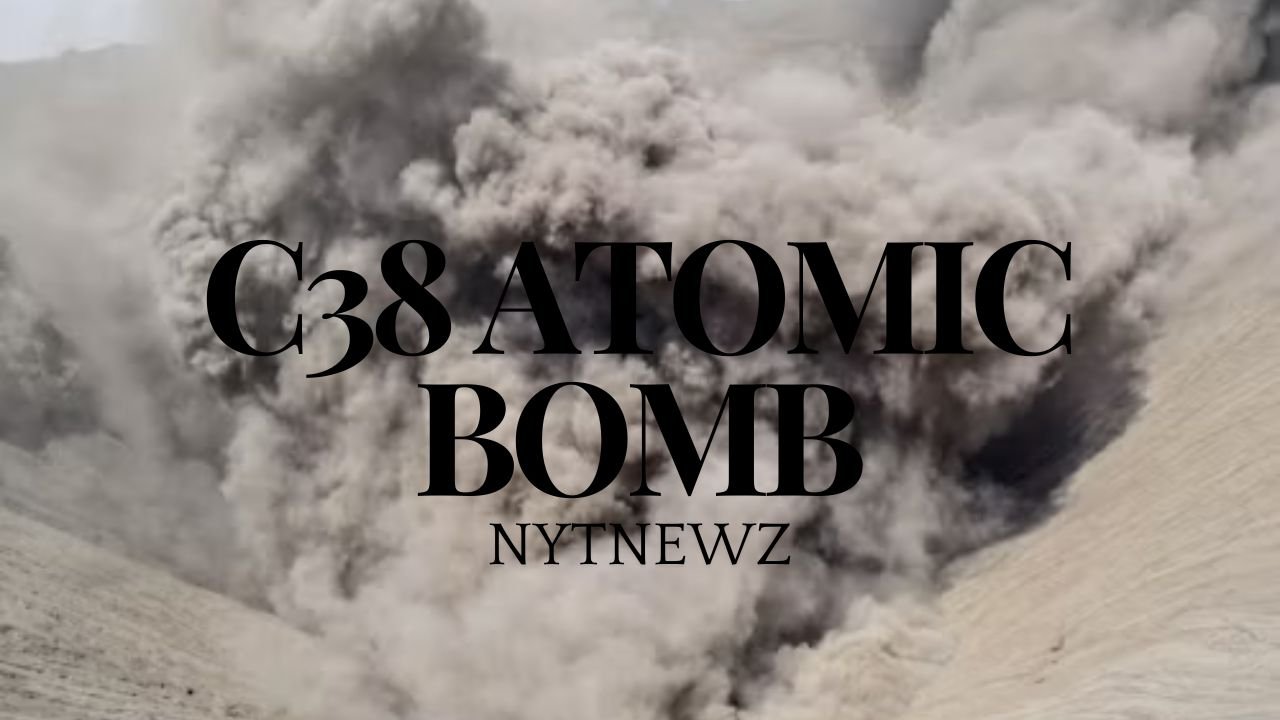The C38 Atomic Bomb: A Speculative Chronicle
Introduction
The idea of the C38 Atomic Bomb has long been a topic of fascination and fear. From the devastating effects of the bombs dropped on Hiroshima and Nagasaki in 1945 to the ongoing issues about nuclear proliferation, the adverse power of nuclear weapons has formed worldwide politics and safety policies for decades. In this speculative exploration, we delve into the fictitious narrative of the C38 atomic bomb—a theoretical advancement in nuclear generation that could redefine the very nature of conflict and global international relations.
The Birth of Element 138
In the 12 months of 2045, a crew of researchers at the European Organization for Nuclear Research (CERN) made a groundbreaking discovery that could for all time adjust the panorama of nuclear physics: Element 138. This superheavy element, created through high-electricity particle collisions, exhibited remarkable balance and reactivity, making it a prime candidate for numerous applications. Initially celebrated for its potential to revolutionize electricity production and clinical technology, Element 138 quickly caught the eye of navy scientists for its viable use in superior weaponry.
Quantum Entanglement:
The incorporation of quantum entanglement into the design of the C38 atomic bomb marked an innovative step in nuclear technology. Quantum entanglement allowed for the synchronization of nuclear reactions at a subatomic level, drastically improving the efficiency of strength release. By entangling debris inside the bomb’s center, scientists may want to ensure an extra whole and speedy fission and fusion procedure, resulting in an explosion some distance greater effective than any preceding nuclear device.
Energy Amplification Techniques
Energy amplification is a cornerstone of the C38 bomb’s negative power. Through superior manipulation of atomic nuclei, researchers advanced strategies to extend the strength output of nuclear reactions. This technique involved particular control over the initiation and progression of each fission and fusion reaction, ensuring that the most amount of electricity changed into released in the shortest feasible time. The result changed into a weapon with a yield exponentially higher than conventional nuclear bombs.
Advanced Metamaterials:
The production of the C38 bomb required substances able to withstand severe situations. Enter advanced metamaterials—engineered materials with residences no longer determined. These materials have been designed to endure the intense warmness, stress, and radiation produced during a nuclear explosion. The bomb’s casing and inner components, crafted from these metamaterials, ensured structural integrity and superior overall performance, pushing the limits of modern-day engineering.
Strategic Shifts in Global Power
The emergence of the C38 atomic bomb might necessarily lead to vast shifts in international strength dynamics. Nations owning this advanced weapon may want to exert exceptional effect to a global degree, changing diplomatic relations and army techniques. The chance of a C38 deployment ought to serve as a powerful deterrent, forcing adversaries to rethink their movements. However, the capability for a new arms race loomed large, as other nations scrambled to broaden their versions of this ambitious weapon.
Ethical Quandaries
The improvement of the C38 atomic bomb introduced the leading-edge urgent ethical dilemmas. Scientists and policymakers grappled with the moral implications of harnessing superior quantum and materials science for detrimental functions. The capability humanitarian impact of deploying this sort of weapon raised serious questions about the responsibilities of those concerned in its advent. The debate highlighted the want for stringent moral standards and oversight inside the realm of nuclear research.
The Role of International Alliances
In the speculative narrative of the C38 bomb, worldwide alliances performed a vital position in each of its improvements and potential deployment. Operation Quantum Storm, the secretive venture at the back of the bomb, became a collaborative attempt related to top scientists and engineers from multiple nations. This alliance underscored the global nature of technological advancements and the importance of worldwide cooperation. However, it also raised issues about the unfolding of touchy information and the risks related to multinational military tasks.
The Voice of Dissent
Amidst the escalating tensions surrounding the C38 bomb, a motion of scientists, activists, and policymakers emerged to recommend peace and disarmament. These individuals, recognizing the dual-use capacity of Element 138, referred to as for its application in peaceful hobbies in preference to military ones. Their efforts emphasized the importance of moral considerations in clinical studies and the need for global collaboration to cope with safety challenges without resorting to similar militarization.
The Brink of Catastrophe
The fictional narrative of the C38 atomic bomb reached its climax as the sector teetered on the threshold of nuclear warfare. A series of provocations and misunderstandings among fundamental powers threatened to trigger the bomb’s deployment, sparking an international disaster. In a race against time, a coalition of diplomats and scientists worked tirelessly to broker a closing-minute peace settlement. Their achievement in stopping a catastrophic battle highlighted the critical importance of international relations and global cooperation in retaining global safety.
The Quantum Accord
The resolution of the crisis surrounding the C38 bomb culminated with the signing of the Quantum Accord, a historic treaty that banned the improvement, deployment, and use of the C38 and comparable superior nuclear guns. This treaty marked a turning factor for international members of the family, paving the manner for a new generation of disarmament and cooperation. The Quantum Accord served as a reminder of the delicate balance between technological progress and global safety, emphasizing the want for collective efforts to ensure a more secure, more nonviolent world.
The Discovery of Quantum Stabilization
The step-forward discovery that enabled the advent of the C38 atomic bomb was called “quantum stabilization.” This system allowed scientists to stabilize the usually unstable superheavy Element 138 lengthy sufficient to control its homes for managed nuclear reactions. Quantum stabilization worried using advanced algorithms and nanotechnology to preserve the integrity of Element 138’s atomic shape, commencing up new possibilities for both nonviolent and army packages.
The Role of Artificial Intelligence
Artificial intelligence (AI) played a pivotal position in the design and improvement of the C38 atomic bomb. AI systems had been employed to model complex nuclear reactions, optimize the bomb’s design, and expect its conduct below numerous conditions. These AI-pushed simulations allowed scientists to refine the bomb’s specs with unprecedented precision, reducing the need for bodily trying out and accelerating the improvement process. The use of AI also highlighted the growing intersection of era and navy innovation.
Cybersecurity Threats
The integration of superior technologies into the C38 bomb’s layout raised massive cybersecurity concerns. As nuclear weapons structures became more and more reliant on virtual infrastructure, the hazard of cyber attacks focused on these structures grew. Protecting the C38 bomb from capacity cyber threats required strong cybersecurity measures, which include encryption, stable verbal exchange protocols, and non-stop monitoring. The need for cybersecurity in nuclear arsenals underscored the evolving nature of battle in the virtual age.
Environmental Impact
The ability environmental impact of the C38 atomic bomb became a first-rate concern for scientists and policymakers alike. The detonation of any such powerful weapon should result in sizeable radioactive infection, affecting ecosystems and human health for generations. Research into the environmental results of the C38 bomb emphasized the want to complete making plans and mitigation techniques to deal with the lengthy-term effects of nuclear explosions. This attention to environmental effects highlighted the broader implications of advanced nuclear technology.
The Rise of Non-State Actors
The improvement of the C38 atomic bomb additionally raised the alarming opportunity for non-kingdom actors to acquire advanced nuclear capabilities. Terrorist companies and rogue entities may want to potentially advantage of access to the technology or materials needed to build comparable guns, posing a tremendous chance for international safety. The upward thrust of non-country actors with nuclear pursuits necessitated better global cooperation and intelligence-sharing to save the proliferation of such guns and ensure they remained below strict manipulation.
The Humanitarian Perspective
The humanitarian perspective on the C38 atomic bomb emphasized the devastating impact of nuclear weapons on civilian populations. Advocacy groups and international corporations referred attention to the indiscriminate nature of nuclear explosions, which can result in massive casualties and lengthy periods of suffering. Efforts to focus on the humanitarian consequences of the C38 bomb performed a vital position in shaping public opinion and influencing policy selections, advocating for disarmament, ent, and the pursuit of nonviolent alternatives.
The Role of the Media
The media played a vital role in shaping public perception of the C38 atomic bomb. Investigative newshounds and media retailers introduced attention to the secretive improvement of the weapon, uncovering information about Operation Quantum Storm and the capacity dangers involved. The media’s coverage fueled public debate and stressed that governments to be obvious about their nuclear packages. The role of the media in this narrative underscored the importance of a loose press and knowledgeable citizenry in democratic societies.
Education and Public Awareness
Increasing public recognition of the implications of the C38 atomic bomb changed into vital for fostering knowledgeable debate and promoting responsible regulations. Educational tasks geared toward explaining the science at the back of the bomb, its capacity effect, and the moral issues involved performed a key function in this attempt. By teaching the general public, scientists and educators were hoping to construct a more informed and engaged citizenry able to contribute to discussions on nuclear policy and global safety.
The Technological Arms Race
The development of the C38 atomic bomb sparked a brand new technological fingers race among some of the international’s leading powers. Nations invested closely in research and development to create their advanced nuclear weapons, main to rapid improvements in associated technologies. This finger race had far-reaching implications for worldwide protection, as countries sought to outpace every difference in both offensive and protective talents. The opposition underscored the want for global agreements to save unchecked escalation.
Disarmament Movements
In response to the threat posed by using the C38 atomic bomb, disarmament movements gained momentum globally. Activists and advocacy organizations campaigned for the removal of nuclear guns, calling for a renewed commitment to disarmament treaties and global cooperation. These movements emphasized the ethical vital of saving the usage of guns of mass destruction and selling peace. Their efforts highlighted the strength of grassroots activism in shaping worldwide guidelines and fostering a tradition of non-violence.
The Legacy of the C38
The legacy of the C38 atomic bomb extended past its instantaneous geopolitical and technological effects. It prompted a re-assessment of the role of technological know-how and generation in society, highlighting the twin-use nature of many improvements. The moral debates and policy decisions surrounding the C38 bomb motivated destiny studies and development practices, encouraging more attention to the capacity consequences of medical breakthroughs. The C38 bomb’s legacy served as a reminder of the want for accountable innovation.
Conclusion
The speculative narrative of the C38 atomic bomb underscores the profound implications of advanced nuclear technology. It highlights the ability for extraordinary destruction, the ethical dilemmas confronted by scientists and policymakers, and the important need for global cooperation and accountable innovation. As we appear to destiny, the training from the C38 story reminds us of the sensitive balance between development and peril. By fostering a culture of peace, moral duty, and worldwide collaboration, humanity can harness technological improvements for the betterment of all, making sure of a safer and extra nonviolent international.
FAQs:
1. What is the C38 atomic bomb?
The C38 atomic bomb is a fictional subsequent-era nuclear weapon, conceptualized the use of advanced principles of quantum physics, substances science, and strength amplification. It represents a speculative jump in nuclear generation with unheard-of destructive power.
2. What makes the C38 atomic bomb one-of-a-kind from traditional nuclear weapons?
The C38 bomb differs from conventional nuclear weapons by utilizing a hybrid mechanism that mixes factors of each nuclear fission and fusion, more advantageous by using quantum entanglement and power amplification techniques. This consequences in a substantially better yield and more green strength release.
3. How does quantum entanglement decorate the C38 bomb’s performance?
Quantum entanglement permits the synchronization of nuclear reactions at a subatomic level. This synchronization guarantees a more complete and speedy fission and fusion technique, maximizing the bomb’s explosive potential as compared to standard nuclear devices.
4. What is Element 138, and why is it huge?
Element 138 is a fictional superheavy element created via high-strength particle collisions. It possesses precise nuclear residences that make it ideal for the C38 bomb’s hybrid response mechanism. Its balance and reactivity are key to the bomb’s unprecedented power.
5. What are the moral implications of growing a weapon like the C38 atomic bomb?
The development of the C38 atomic bomb increases tremendous moral issues, which include the potential for catastrophic humanitarian impact, environmental devastation, and the obligations of scientists and policymakers in harnessing advanced technologies for detrimental functions.
Read More Luther Social Media Maven Keezy.co: A Trailblazer in Digital Marketing 2024




Post Comment